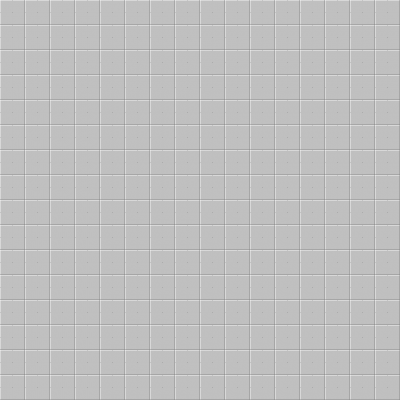Grid
The grid is used to refer to the tile area where Chip's Challenge is played. In Chip's Challenge 1, the grid is always 32x32. In Chip's Challenge 2, the grid size depends on the level; it can be as small as 10x10 or as large as 100x100 (although no official levels are larger than 40x40) and does not have to be square.
The grid's squares are marked as X/Y coordinates, from [0, 0] to [31, 31] in level editors and in solution guides, commonly to refer to connections of traps or clone machines, or to indicate where a specific object is found at. In Chip's Challenge 2, the X/Y coordinates can go as high as [99, 99].
This is the CC1 grid blank:
The grid in CC1 has two layers. In MS they are upper and lower; in Lynx they are object and terrain.
The grid in level editors
To see the entire grid, the editor can be zoomed in and out. ChipEdit and Chip's Workshop use scale; CCEdit, CCLD and CCCreator use zoom. This can also be used to generate maps in any square size. Be warned that ChipEdit's zoom quality is extremely muddy to awful, depending on the scale factor. To make maps in ChipEdit, zoom back to normal size before repasting the grid into Paint or PowerPoint. For maps in Tile World tiles, use CCEdit.
The grid in play
In CC1, Chip will always be in a 9x9 grid, generally in the center, unless he is located on row or column 0, 1, 2, 3, 28, 29, 30, or 31, three or fewer spaces from the edge of the grid, in which case the missing nine spaces on that side will transfer to the other side. Therefore, Chip at [30, 5] will see from [23, 1] to [31, 9]. Either way, he will always see 81 tiles.
In CC2, the grid, there are three possible viewports: 9x9, 10x10 and split. 9x9 behaves like in CC1. In 10x10, Chip or Melinda remains in the center, and can see half of the tiles on all sides (except if near the edge, like in CC1). As a consequence, the player can see at least part of 100, 110 or 121 tiles, depending on where they are on the map.
In the original Atari Lynx version of Chip's Challenge, touching the outside boundary of the grid could cause unpredictable results. In the MS ruleset, Tile World's Lynx emulation, and Chip's Challenge 2, the boundaries act as thin walls in their direction instead.
Grid construction
In the MS ruleset, objects on the lower grid will appear or be erased from the level when the square they are under is stepped on, depending on what runs into them; monsters will erase anything on the lower layer of a tile they cross, and Chip and blocks will reveal the tile. Whether the object takes effect on Chip depends on what it is; traps and exits, with an exception in the case of a connected but buried trap, which does not work on first passage, are the only two tiles which immediately have their effect.
In the Lynx ruleset, all tiles consist of a terrain and (optionally) an object. Objects include Chip, blocks and all types of monsters; all other tiles count as terrains. The object, if it is present, is always on top. Any other combination of tiles such as two objects (for example, a monster under a block), two terrains (for example, water under a bomb) or a terrain over an object (for example, a block under dirt) are invalid and render the level unplayable.
The grid in this level guide
Many pages for monsters and other demonstrational diagrams are treated as small grids with identical numbering systems, and they may or may not be square.
